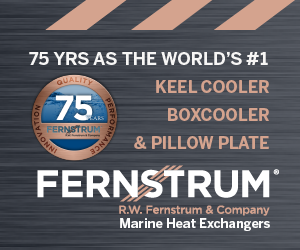Marine Compliance Alliance Hosts Luncheon In New Orleans
The Marine Compliance Alliance, an association of inland marine compliance professionals focused on sharing lessons learned and best practices, while also serving as a unified voice on behalf of operators with regard to safety, security and environmental protection, held its most recent meeting and luncheon December 12 in New Orleans.
Rear Adm. David Barata, commander of the Eighth Coast Guard District, was the keynote speaker. The agenda also covered the topics of Subchapter M’s stability subdivision, a lesson learned from an operator, the management of change process, a discussion of the U.S. Coast Guard’s SASH (sexual assault and sexual harassment) policies and a presentation by Capt. Bradley Clare from the Coast Guard’s National Maritime Center.
Rick Dunn, president of SafeMARINER LLC, opened the meeting with a talk on leveraging the management of change process. Dunn described the management of change as a structured process.
“It’s a safety tool that, if used properly, will reduce risk in an organization,” Dunn said.
Dunn explained that hazards may be introduced to the working environment through the course of normal operations, whether navigating a new area; modifying a feature on a boat, barge or dock; adding new equipment, a new cargo or a new procedure; or enacting significant change in a company. The management of change process, then, recognizes and assesses those hazards and manages those hazards to reduce risk.
“It’s really that simple,” Dunn said.
Dunn went on to discuss how to follow up and validate that changes implemented are working as intended and how to garner support within the organization for those changes. Dunn also said it’s best for companies to be proactive and not reactive, in terms of identifying hazards and implementing changes.
“It’s not that easy,” he said. “It sounds easy, but it’s not.”
Luis Carmona, retired Coast Guard commander and founder of Semper Maritime, then offered an in-depth look at Subchapter M’s stability and subdivision requirements, including necessary documents for vessels and steps vessel captains must take prior to getting underway to maintain watertight integrity.
Following up on Carmona’s presentation, Mark Sawyer, executive director of Marine Compliance Alliance, who also leads Marathon Petroleum’s marine operations compliance, urged operators to be mindful of adding equipment to vessels or materially modifying vessels.
“Please keep in mind that, for existing vessels, as you modify your vessel, potentially adding weight, it could impact displacement, thus needing to re-evaluate stability by performing a stability test,” Sawyer said.
Next, Brian Khey, vice president of compliance for Marquette Transportation’s river division and board president of the Marine Compliance Alliance, shared a real-life lesson learned with members. The scenario involved a steersman in training, alongside a master, guiding an empty red flag barge into a fleet. As the tow came alongside a loaded red flag barge in the fleet, the steersman “failed to kill the slide,” Khey said, which resulted in the rake of the empty barge going on top of the loaded barge. The lesson learned, Khey said, was to discuss with the master when to take over for a trainee and when the trainee should admit that he or she needs help.
“Some of them will say, ‘Well, you have to fail sometime,’” Khey said. “But you shouldn’t fail at the expense of people, equipment or the environment.”
In his keynote, Barata emphasized communication as it relates to how operators interact with the Coast Guard. Particularly with regard to Subchapter M inspections and credentialing, Barata said operators should always feel free to reach out to an OCMI (Officer in Charge, Marine Inspection) whenever an appeal is warranted.
“As you’re working with your OCMI, you should feel free to bring it up,” Barata said. “The regs incorporate that kind of conversation where you can bring that up to the OCMI. There’s no end-all, be-all. Eventually it will get to my desk and to Coast Guard headquarters, and there’s no retribution there. That is just a conversation.”
Barata also touched on topics like remote operation of movable bridges, infrastructure needs, autonomous operations, alternative fuels and recruitment challenges—issues that both industry and the Coast Guard will face for the foreseeable future.
Following Barata, Clare recognized Capt. Terry Dietz, a captain with Ingram Barge Company who has more than 30 years in the wheelhouse and more than 44 years working on towboats. The Coast Guard is in the process of transitioning away from its current Merchant Mariner Credential printers, which are old and difficult to repair. In doing so, Clare said the Coast Guard’s National Maritime Center wanted to honor a longtime captain with the first credential from the new printers. When the new printers come online in the next month or two, Dietz will receive the first credential.
Closing out the meeting, Matt Layman, from the Coast Guard’s Office of Operating and Environmental Standards, discussed the Coast Guard’s recently installed SASH policies. Several industry representatives present for the meeting asked for a more precise definition of harassment, distinct from sexual harassment.
Also during the meeting, Sawyer recognized two Marine Compliance Alliance members who rotated off the board of directors at the end of the year: Capt. Lee Nelson, president of Henderson, Ky.-based iTow, and Eric Brumfield, manager of inspections and documentation for Florida Marine Transporters. New board members include Chris Bushhorn, vice president of administrative services for Parker Towing Company, and Robert Keister, vice president of Sabine Surveyors.
The next meeting and luncheon is already on the calendar for the Marine Compliance Alliance. The group will gather February 8 at Big Ed’s in Paducah, Ky. For more information, visit www.marinecompliancealliance.com.



